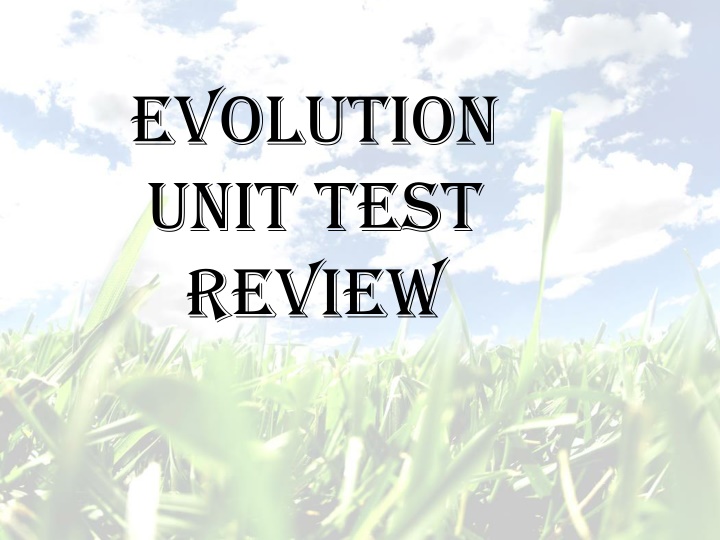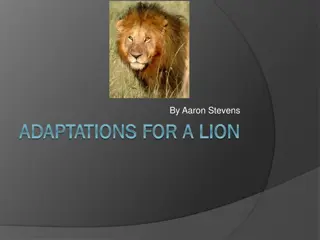Evolution Unit Test Review - Adaptations and Benefits Matching
In this review, you will match various adaptations to the benefits they provide in the context of evolution. From heavy fur of the Snow Leopard to wing-like shape of maple seeds, explore how different adaptations help organisms cope with climate, obtain food and water, attract mates, escape predators, and facilitate seed dispersal. Enhance your understanding of evolutionary concepts through this interactive adaptation and benefit matching exercise.
Download Presentation

Please find below an Image/Link to download the presentation.
The content on the website is provided AS IS for your information and personal use only. It may not be sold, licensed, or shared on other websites without obtaining consent from the author.If you encounter any issues during the download, it is possible that the publisher has removed the file from their server.
You are allowed to download the files provided on this website for personal or commercial use, subject to the condition that they are used lawfully. All files are the property of their respective owners.
The content on the website is provided AS IS for your information and personal use only. It may not be sold, licensed, or shared on other websites without obtaining consent from the author.
E N D
Presentation Transcript
Evolution Unit Test Review
Match the adaptation to the benefits listed Heavy fur of the Snow Leopard Coping with climate Obtaining Food and Water Attracting Mates Escaping Predators Seed Dispersal
Match the adaptation to the benefits listed Cockle burs that hook onto passing animal fur Coping with climate Obtaining Food and Water Attracting Mates Escaping Predators Seed Dispersal
Match the adaptation to the benefits listed Wing-like shape of maple seeds Coping with climate Obtaining Food and Water Attracting Mates Escaping Predators Seed Dispersal
Match the adaptation to the benefits listed White fur and large feet of a Snowshoe Hare Coping with climate Obtaining Food and Water Attracting Mates Escaping Predators Seed Dispersal
Match the adaptation to the benefits listed Thick fat layer on seals Coping with climate Obtaining Food and Water Attracting Mates Escaping Predators Seed Dispersal
Match the adaptation to the benefits listed Web of a house spider Coping with climate Obtaining Food and Water Attracting Mates Escaping Predators Seed Dispersal
Match the adaptation to the benefits listed Light-colored peppered moths in unpolluted forests Coping with climate Obtaining Food and Water Attracting Mates Escaping Predators Seed Dispersal
Match the adaptation to the benefits listed A male cardinal s bright red feathers Coping with climate Obtaining Food and Water Attracting Mates Escaping Predators Seed Dispersal
Multiple Choice Which of the following is an example of variation? A. Traces or remains ancient organisms B. Light and dark forms of the peppered moth C. Mimicry D. Bird wings and insect wings
Multiple Choice Traits that allow an organism to survive and produce offspring are called A. variations B. adaptations C. Vestigial structures D. Homologous structures
Multiple Choice Scientists use all of the following to support the theory of evolution through natural selection EXCEPT A. Fossil evidence B. Comparative anatomy and homologous structures C. Vestigial structures D. Genetic engineering
Multiple Choice Darwin s theory of evolution is based upon the concept of A. Selective breeding B. mutations C. Natural selection D. hybridization
Multiple Choice DNA copying errors can cause changes in the traits of organisms. These copying errors are called A. Homologous structures B. genes C. variations D. mutations
Multiple Choice Vestigial structures A. Include root hairs in plants and the elaborate camouflage of certain spiders B. Are beneficial adaptations C. No longer exist D. Have no function in present organisms
Multiple Choice The preserved remains or traces of an organism that lived in the past A. mutations B. fossils C. vestigal structures D. adaptations
Multiple Choice Evolution is best defined as C. The process of one species turning into another species A. Gradual change in a species over time B. The passing of traits from one generation to the next D. Differences between members of a species
Multiple Choice The spotted touch-me-not is a flowering plant. It has seed pods that burst open when touched and forcefully eject their seeds. This adaptation is beneficial because it A. Causes genetic changes in the plant C. Helps disperse the seeds of the plant B. Attracts insects that pollinate the plant D. Conserves the plant s energy
Multiple Choice Which of the following is an example of mimicry? A. Elephants traveling in herds C. Stick insects (walking sticks) that resembles sticks and twigs B. Zebras confusing predators using optical illusions D. Swordfish that resemble a Renaissance sword
Multiple Choice Bird predators eat high percentages of light colored moths in forests where there are high levels of pollution. Dark colored peppered moths are, therefore, better adapted to survive and reproduce. This is an example A. Natural selection C. mutations B. macroevolution D. Artificial selection
Multiple Choice Similarities in the bone structure of a chimpanzee s arm and of a bird s wing A. Show that the chimpanzees are an older species than birds C. Are an example of variations within a species B. Provide evidence of a common ancestor for the species D. Are an example of vestigial structures























